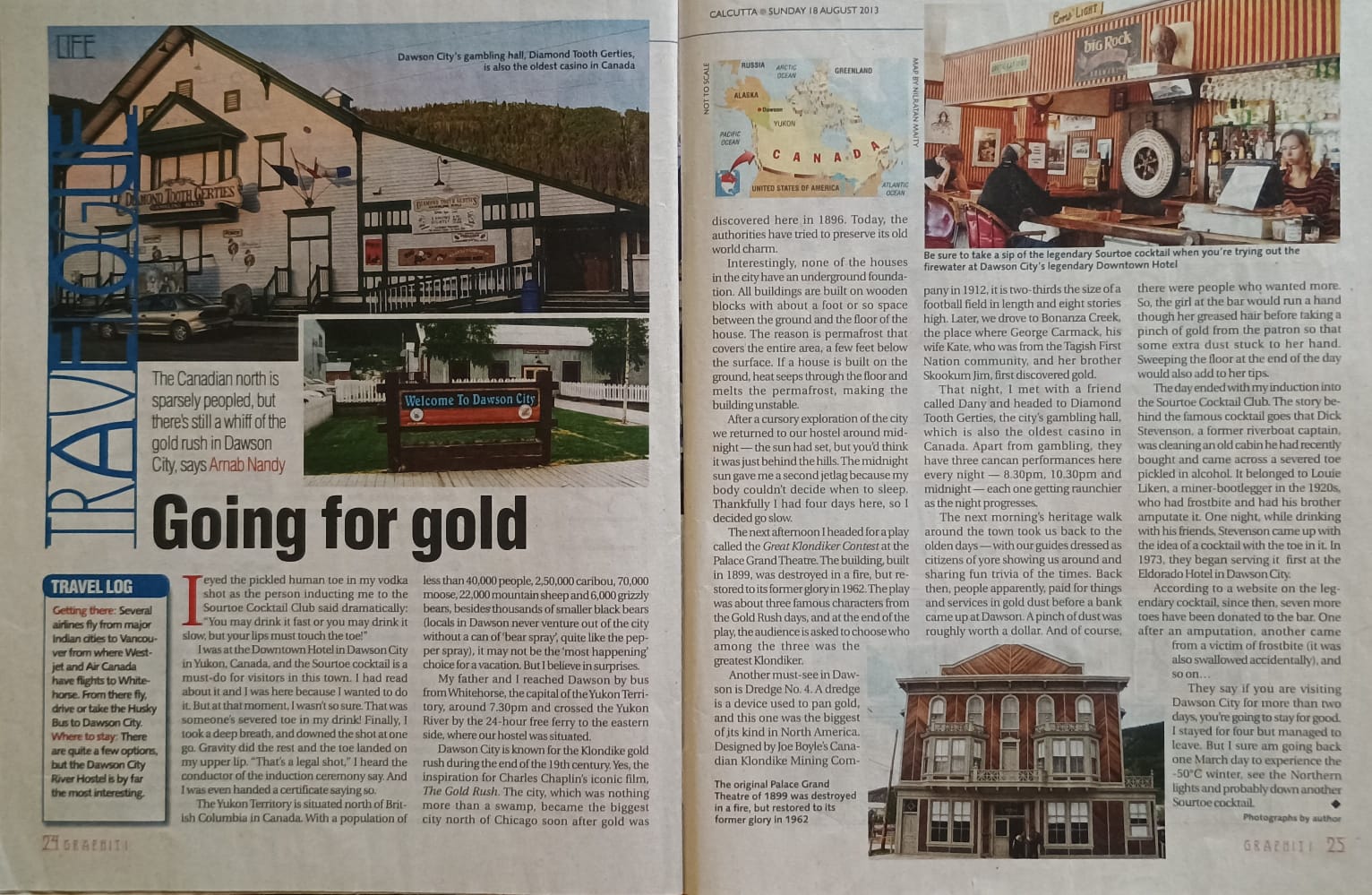I eyed the pickled human toe in my vodka shot as the person inducting me to the Sourtoe Cocktail Club said dramatically: “You may drink it fast or you may drink it slow, but your lips must touch the toe!”
I was at the Downtown Hotel in Dawson City in Yukon, Canada, and the Sourtoe cocktail is a must-do for visitors in this town. I had read about it and I was here because I wanted to do it. But at that moment, I wasn’t so sure. That was someone’s severed toe in my drink! Finally, took a deep breath, and downed the shot at one go. Gravity did the rest and the toe landed on my upper lip. “That’s a legal shot,” I heard the conductor of the induction ceremony say. And I was even handed a certificate saying so.
The Yukon Territory is situated north of British Columbia in Canada. With a population of less than 40,000 people, 2,50,000 caribou, 70,000 moose, 22,000 mountain sheep and 6,000 grizzly bears, besides thousands of smaller black bears (locals in Dawson never venture out of the city without a can of ‘bear spray’, quite like the pep- per spray), it may not be the ‘most happening choice for a vacation. But I believe in surprises.
My father and I reached Dawson by bus from Whitehorse, the capital of the Yukon Terri tory, around 7.30pm and crossed the Yukon River by the 24-hour free ferry to the eastern side, where our hostel was situated.
Dawson City is known for the Klondike gold rush during the end of the 19th century. Yes, the inspiration for Charles Chaplin’s iconic film, The Gold Rush. The city, which was nothing more than a swamp, became the biggest city north of Chicago soon after gold was discovered here in 1896. Today, the authorities have tried to preserve its old world charm.
Interestingly, none of the houses in the city have an underground foundation. All buildings are built on wooden blocks with about a foot or so space between the ground and the floor of the house. The reason is permafrost that covers the entire area, a few feet below the surface. If a house is built on the ground, heat seeps through the floor and melts the permafrost, making the building unstable.
After a cursory exploration of the city we returned to our hostel around mid- night – the sun had set, but you’d think it was just behind the hills. The midnight sun gave me a second jetlag because my body couldn’t decide when to sleep. Thankfully I had four days here, so I decided go slow.
The next afternoon I headed for a play called the Great Klondiker Contest at the Palace Grand Theatre. The building, built in 1899, was destroyed in a fire, but restored to its former glory in 1962. The play was about three famous characters from the Gold Rush days, and at the end of the play, the audience is asked to choose who among the three was the greatest Klondiker.
Another must-see in Dawson is Dredge No. 4. A dredge is a device used to pan gold, and this one was the biggest of its kind in North America. Designed by Joe Boyle’s Canadian Klondike Mining Company in 1912, it is two-thirds the size of a football field in length and eight stories high. Later, we drove to Bonanza Creek, the place where George Carmack, his wife Kate, who was from the Tagish First Nation community, and her brother Skookum Jim, first discovered gold.
That night, I met with a friend called Dany and headed to Diamond Tooth Gerties, the city’s gambling hall, which is also the oldest casino in Canada. Apart from gambling, they have three cancan performances here every night-8.30pm, 10.30pm and midnight – each one getting raunchier as the night progresses.
The next morning’s heritage walk around the town took us back to the olden days – with our guides dressed as citizens of yore showing us around and sharing fun trivia of the times. Back then, people apparently, paid for things and services in gold dust before a bank came up at Dawson. A pinch of dust was roughly worth a dollar. And of course, there were people who wanted more. So, the girl at the bar would run a hand though her greased hair before taking a pinch of gold from the patron so that some extra dust stuck to her hand. Sweeping the floor at the end of the day would also add to her tips.
The day ended with my induction into the Sourtoe Cocktail Club. The story behind the famous cocktail goes that Dick Stevenson, a former riverboat captain, was cleaning an old cabin he had recently bought and came across a severed toe pickled in alcohol. It belonged to Louie Liken, a miner-bootlegger in the 1920s, who had frostbite and had his brother amputate it. One night, while drinking with his friends, Stevenson came up with the idea of a cocktail with the toe in it. In 1973, they began serving it first at the Eldorado Hotel in Dawson City.
According to a website on the legendary cocktail, since then, seven more toes have been donated to the bar. One after an amputation, another came from a victim of frostbite (it was also swallowed accidentally), and so on…
They say if you are visiting Dawson City for more than two days, you’re going to stay for good. I stayed for four but managed to leave. But I sure am going back one March day to experience the -50°C winter, see the Northern lights and probably down another Sourtoe cocktail.
